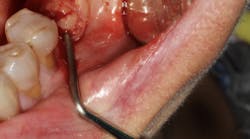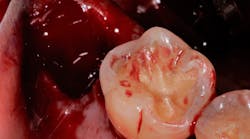A review of bone graft material
After trauma or infection, bone heals by both regeneration and repair. Regeneration can be defined as reproduction or reconstitution of a lost or injured part, a biologic process by which the architecture and function of lost tissues are completely restored. Repair can be defined as the healing of a wound by tissue that does not fully restore the architecture or function of the part. The phases of bone healing involve blood clotting, wound cleansing, tissue formation, and tissue modeling and remodeling. Factors that interfere with bone healing include failure of vessels to proliferate into the wound, improper stabilization of the coagulum and granulation tissue into the defect, ingrowth of “non-osseous” or fibrous tissues with a high proliferative activity, and bacterial contamination.
The prerequisites for bone regeneration are cells, molecules, scaffold, and blood supply. First, a supply of bone-forming cells or cells with the capacity to differentiate into bone-forming cells is required. Next, the presence of osteoinductive stimuli to initiate the differentiation of mesenchymal cells into osteoblasts is needed. Finally, an osteoconductive environment forming a scaffold upon which invading tissue can proliferate and in which the stimulated osteoprogenitor cells can differentiate into osteoblasts and form bone and an adequate blood supply complete the tetrad of prerequisites for bone regeneration.
Schallhorn (1972), stated that the goals of osseous grafting are pocket elimination, restoration of the lost alveolar process, and regeneration of a functional attachment apparatus. Different types of osseous grafts include autografts, allografts, xenografts, and alloplasts. Autografts can be defined as tissue transferred from one position to another within the same individual. Allografts can be defined as tissue transferred from one individual to another genetically dissimilar individual of the same species. Xenografts can be defined as tissue transferred from one species to another species. And, alloplasts can be defined as a synthetic graft or inert foreign body implanted into tissue. Zaner and Yukna (1984) examined the particle size of different types of bone grafts and determined that a particle size of about 380μm would be most appropriate.
Schallhorn and Hiatt (1972) grafted 194 sites of varying morphology with iliac crest allografts. They noted that their results were similar to autogenous grafts; histology indicated replacement of the allograft with viable bone and evidence of root resorption. Three of 20 patients developed cytotoxic antibody activity to a panel of human lymphocytes. Since then, frozen allogenic iliac crest allograft use has virtually been eliminated in periodontics due to the risk of disease transmission.
In 1976, Mellonig et al. used freeze-dried cortical bone allografts implanted into 97 wide 3,2,1-wall combination and furcation defects. They showed that 23 sites had complete bone regeneration, and 39 other sites displayed greater than 50% osseous repair. Mellonig concluded that “There is strong evidence which indicates that freeze-dried bone allografts have definite potential as grafting material in certain periodontal osseous defects.” Sepe (1978) performed a study in which 800 defects were grafted by 53 different periodontists with FDBA and determined that 60% of sites had more than 50% fill.
In 1968, Urist implanted samples of 0.6N HCL decalcified lyophilized diaphyseal bone matrix, intramuscularly and subcutaneously, into six adult rats. Experimental mice displayed ectopic bone formation and these early studies lead to the theory that demineralized freeze-dried bone allografts are osteoinductive due to the exposure of the BMPs. There are mixed results among leading studies on the inductive capabilities of these DFDBA grafts. Becker et al. (1995) showed histologically that commercial DFDBA induced minimal amounts of new appositional bone (7.5% to 21.6%). However, Urist (1996) showed that partially purified human BMP preparations resulted in 96% of the field filled with new appositional bone. It has been determined that there are many factors that may be involved in the osteogenic capability of DFDBAs. These include age of the donor (Schwartz 1998), content of bone inductive factors in the donor bone (Becker 1995), residuals of ethylene oxide (Tshamala 1999) or radiation (Zang 1997) due to inadequate evacuation during sterilization and exposure to temperatures that produce denaturation.
Xenografts are bone grafts transferred from one species to another species. The main xenografts used in bone grafting procedures are derived from bovine bone. They are Pepgen 21, Osteograf N, and Bio-oss. Pepgen 21 is a polypeptide bound to anorganic bovine hydroxyapatite. Fifteen amino acid sequence on the end of a linear polypeptide contains RGD units involved in the binding of cells. It may be efficacious in controlled studies; however, heat treatment alters the stoic geometry of the HA leading to a spherical configuration that is not recognized and lowers the clinical effectiveness. Osteograf N is bovine bone that is also processed at high temperature, which removes proteins from the graft. This high temperature may also alter the stoic geometry of the bone graft material. Finally, Bio-oss is bovine bone processed at lower heat with organic solvents and has a porosity similar to human bone. These xenografts act as an osteoconductive matrix and maintain the space of a defect in the alveolar bone to allow for osteoprogenitor cells to migrate, regenerate, and repair.
Another type of bone graft is the alloplasts, which is implanting a synthetic, inert material. They are osteoconductive, may be resorbable or nonresorbable, and are derived from either polymers, nonceramics, or bioceramics. Froum (1987) found that beta tri calcium phosphate, a partially resorbable bioceramic alloplast, actually becomes encapsulated with host connective tissue. These alloplasts simply act as an inert space filler.
As research progresses in the field of alveolar bone and grafting materials, there are many exciting developments that may have profound impacts on bone grafting. The future is in biologics. Currently, platelet-derived growth factors, enamel matrix derivative, and bone morphogenic proteins are being used clinically either alone or in combination with bone graft materials and showing good results. As research progresses, there will be different growth and differentiation factors, and they may potentially increase the indications of graftable sites.
Author bioReferences
Becker W, Urist MR, Tucker LM, Becker BE, Ochsenbein C. Human demineralized freeze-dried bone: inadequate induced bone formation in athymic mice. A preliminary report. Journal of Periodontology 1995; 66:822–828.
Becker W, Urist MR, Becker BE et al. Clinical and histologic observation of sites implanted with intraoral autologous bone grafts or allografts. 15 human case reports. Journal of Periodontology 1996; 67:1025-1033.
Friedenstein AJ, Lalykina KS. Thymus cells are inducible to osteogenesis. European Journal of Immunology 1972; 2:602-603.
Froum S, Stahl SS. Human intraosseous healing responses to the placement of tricalcium phosphate ceramic implants. II. 13 to 18 months. Journal of Periodontology 1987; 58:103-109.
Giannobile WV, Somerman MJ. Growth and amelogenin-like factors in periodontal wound healing. A systematic review. Annals of Periodontology 2003; 8:193–204.
Krane SM. Genetic control of bone remodeling — insights from a rare disease. New England Journal of Medicine 2002; 347:210-212.
McCauley LK, Nohutcu RM. Mediators of periodontal osseous destruction and remodeling: principles and implications for diagnosis and therapy. Journal of Periodontology 2002; 73:1377-1391.
Mellonig JT, Bowers GM, Bright RW, Lawrence JJ. Clinical evaluation of freeze-dried bone allografts in periodontal osseous defects. Journal of Periodontology 1976; 47:125-131.
Reynolds MA, Aichelmann-Reidy ME, Branch-Mays GL, Gunsolley JC. The efficacy of bone replacement grafts in the treatment of periodontal osseous defects. A systematic review. Annals of Periodontology 2003; 8:227–265.
Schallhorn RG. Postoperative problems associated with iliac transplants. Journal of Periodontology 1972; 43:3-9.
Schallhorn RG, Hiatt W. Human allografts of iliac cancellous bone and marrow in periodontal osseous defects II. Clinical observations. Journal of Periodontology 1972; 43:67-81.
Schwartz Z, Mellonig JT, Carnes DL Jr. et al. Ability of commercial demineralized freeze-dried bone allograft to induce new bone formation. Journal of Periodontology 1996; 67:918-926.
Schwartz Z, Somers A, Mellonig JT et al. Ability of commercial demineralized freeze-dried bone allograft to induce new bone formation is dependent on donor age but not gender. Journal of Periodontology 1998; 69:470-478.
Sepe WW, Bowers GM, Lawrence JJ, Friedlaender GE, Koch RW. Clinical evaluation of freeze-dried bone allografts in periodontal osseous defects: Part II. Journal of Periodontology 1978; 49:9-14.
Tshamala M, Cox E, De Cock J, Goddeeris BM, Mattheeuws D. Antigenicity of cortical bone allografts in dogs and effect of ethylene oxide sterilization. Veterinary Immunology and Immunopathology 1999; 69:47-59.
Urist MR. Bone: Formation by autoinduction. Science 1965; 150:893-899.
Urist MR, Dowell TA, Hay PH, Startes BS. Inductive substrates for bone rormation. Orthopaedics and Related Research 1968; 59:59-96.
Zaner DJ, Yukna RA. Particle size of periodontal bone grafting materials. Journal of Periodontology 1984; 55:406-409.
Zhang M, Powers RM, Wolfinbarger L. Effect(s) of the demineralization process on the osteoinductivity of demineralized bone matrix. Journal of Periodontology1997; 68:1085-1092.
Zhang Q, Cornu O, Delloye C. Ethylene oxide does not extinguish the osteoinductive capacity of demineralized bone. A reappraisal in rats. Acta Orthopaedica 1997; 68:104-108.


